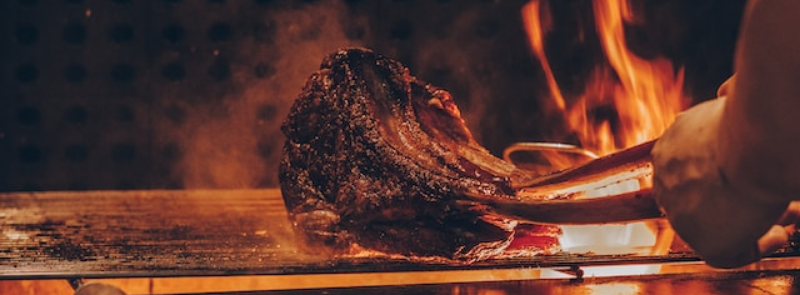
When It Occurs
Every April 27th
Timeline
Days Passed (900)
# Hashtags
#NationalPrimeRibDay #SteakhouseCooking
Celebrate National Prime Rib Day on April 27 by indulging in a visit to our preferred steakhouse. Also referred to as "standing rib roast," prime rib is a delectably tender and flavorful cut from the rib section of the steer, representing one of the eight prime cuts of beef. While the traditional pairing involves potatoes, stuffing, and vegetables for a classic "Sunday Roast," the versatility of prime rib allows for a myriad of unique flavors and recipes. It's a succulent celebration that we wholeheartedly endorse!
Historical Background
What Is Prime Rib?
- Prime Rib Defined: Prime rib, also known as a standing rib roast, is a cut of beef from the primal rib section of the cow. It includes the ribeye muscle and is known for its marbling, which contributes to its tenderness and flavor. The "prime" in prime rib does not necessarily mean that the meat is graded as "Prime" by the USDA, although it often is. The term refers more to the cut of meat rather than its grade.
- Culinary Tradition: Prime rib has long been a staple in American cuisine, particularly during festive occasions like Christmas, Thanksgiving, and Easter. Its association with luxury and celebration has made it a popular choice for special dinners.
Origins of National Prime Rib Day:
- The National Prime Rib Day has become an annual celebration among food enthusiasts and restaurants. The day likely emerged from a desire to celebrate this iconic cut of beef and to promote its enjoyment in both restaurants and home kitchens.
Purpose and Objectives
Celebrating a Culinary Favorite:
- The primary goal of National Prime Rib Day is to celebrate the deliciousness and culinary excellence of prime rib. The day encourages people to enjoy prime rib in various forms, whether it's a classic roast, a ribeye steak, or even in sandwiches and other dishes.
Promoting Cooking and Dining Experiences:
- National Prime Rib Day also aims to promote both home cooking and dining out. It encourages food lovers to experiment with preparing prime rib at home, as well as to support local restaurants that serve this cut of meat.
Educating About Prime Rib:
- The day serves as an opportunity to educate people about prime rib, including how to select, prepare, and cook it to perfection. It also highlights the different ways prime rib can be enjoyed, from traditional roasting to creative recipes.
Celebrating National Prime Rib Day
Dining Out:
- Many steakhouses and restaurants offer special deals or featured prime rib dishes on National Prime Rib Day. Dining out at a restaurant that specializes in prime rib is a popular way to celebrate, allowing you to enjoy a perfectly cooked prime rib without the effort of preparing it at home.
Cooking Prime Rib at Home:
- For those who enjoy cooking, National Prime Rib Day is the perfect occasion to try your hand at preparing a prime rib roast. Cooking prime rib at home can be a rewarding experience, especially when shared with family and friends. Traditional recipes often involve roasting the prime rib in the oven, seasoned simply with salt, pepper, and garlic, and served with au jus and horseradish sauce.
Experimenting with Recipes:
- While the classic roast is always a favorite, some people use National Prime Rib Day to experiment with different recipes. This might include smoked prime rib, herb-crusted prime rib, or even prime rib sandwiches. The versatility of this cut allows for a range of delicious culinary creations.
Learning About Prime Rib:
- National Prime Rib Day is also a great time to learn more about this cut of meat. Resources such as cookbooks, online tutorials, and cooking classes can provide valuable information on how to select, prepare, and cook prime rib to perfection.
Hosting a Prime Rib Dinner:
- Hosting a prime rib dinner at home is another popular way to celebrate. Whether for family, friends, or a small gathering, a prime rib roast makes an impressive and satisfying meal. Pairing the meal with complementary sides like roasted vegetables, mashed potatoes, or Yorkshire pudding can enhance the dining experience.
How to Cook Prime Rib
Selecting the Prime Rib:
- When choosing a prime rib, consider the grade of the meat. USDA Prime is the highest grade and offers the most marbling, which contributes to flavor and tenderness. However, USDA Choice is also a good option and is more widely available.
- Decide whether you want a bone-in or boneless roast. Bone-in prime rib is often preferred for its flavor and presentation, but boneless is easier to carve.
Preparing the Prime Rib:
- Start by allowing the prime rib to come to room temperature before cooking. This helps ensure even cooking.
- Season the roast generously with salt, pepper, and other herbs or spices as desired. Some people like to create a garlic and herb crust for added flavor.
Cooking the Prime Rib:
- Roasting Method: Preheat the oven to a high temperature (around 450°F or 232°C) and cook the prime rib for 15 minutes to create a crust. Then, reduce the oven temperature to 325°F (163°C) and continue cooking until the internal temperature reaches your desired level of doneness (e.g., 120-125°F for medium-rare).
- Resting: Once the prime rib is cooked, it’s important to let it rest for at least 20 minutes before carving. This allows the juices to redistribute, resulting in a juicier and more flavorful roast.
Serving Suggestions:
- Prime rib is traditionally served with au jus (a light beef broth) and horseradish sauce. Yorkshire pudding, roasted vegetables, and mashed potatoes are popular side dishes that complement the richness of the meat.
Fun Facts About Prime Rib
- "Prime" Grade: The term "prime rib" can sometimes be confusing. While "prime" refers to the USDA's highest grade of beef, "prime rib" can be a cut from any grade. However, prime-grade beef is the most marbled and flavorful.
- Historical Favorite: Prime rib has been a traditional centerpiece at many American holiday tables for generations, especially during Christmas and New Year's Eve.
- Bone-In vs. Boneless: Bone-in prime rib is often preferred for its flavor, but boneless prime rib is easier to cook evenly and slice.
Prime Rib in Popular Culture
Steakhouses and Restaurants:
- Prime rib is a staple on the menu at many classic American steakhouses, where it is often slow-roasted and served with traditional accompaniments like creamed spinach and baked potatoes.
Holiday Traditions:
- For many families, prime rib is a holiday tradition, particularly around Christmas or New Year’s Eve. The rich, savory flavor of prime rib makes it a favorite for special occasions.
Culinary Shows and Competitions:
- Prime rib often features in cooking shows and culinary competitions, where chefs showcase their skills in preparing this luxurious cut of beef. It is prized for its flavor, texture, and the skill required to cook it perfectly.
Conclusion
National Prime Rib Day is a celebration of one of the most beloved cuts of beef in American cuisine. Whether you’re dining out at a steakhouse, cooking a roast at home, or exploring new recipes, this day is all about indulging in the rich, savory flavors of prime rib. It’s a day for meat lovers to come together, appreciate the art of cooking, and enjoy a delicious meal centered around this classic cut. Whether enjoyed as a simple roast or as part of a more elaborate culinary creation, prime rib continues to hold a special place in the hearts (and stomachs) of those who appreciate good food.


